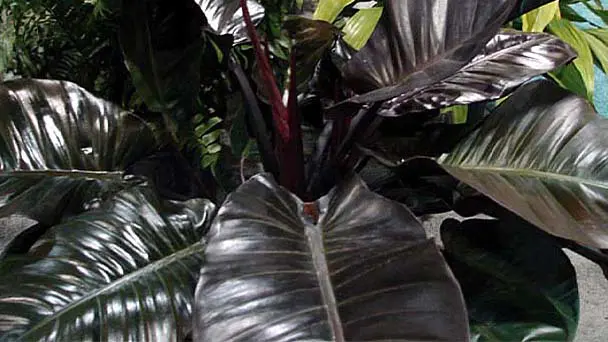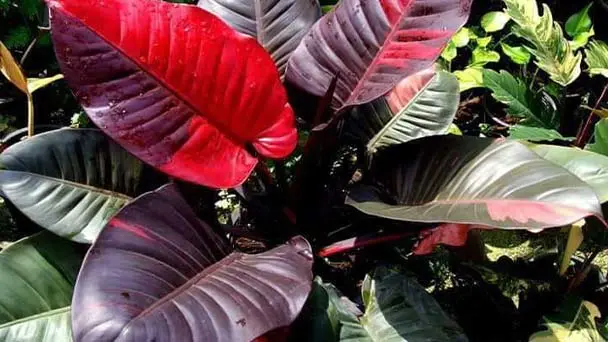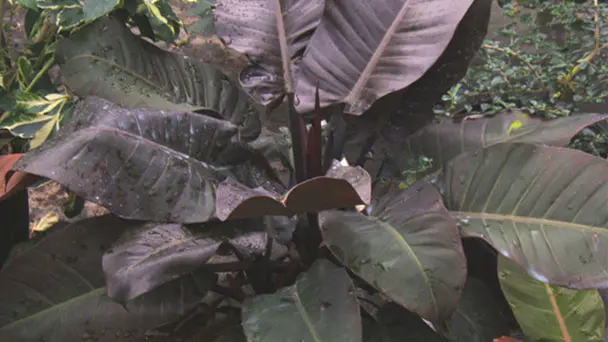Philodendron Black Cardinal Care & Propagation Guide
Written by Ivy
Jan 07 2023

Philodendron Black cardinal will grow with age, the leaves will increase, the main stem will continue to increase, and several leaves will be separated from the increased main stem. Philodendron Black cardinal leaves are plump and glossy, the back of main vein and side vein is convex, the petiole is more than 30 cm long, the upper part is grooved and hairless.
There are two yellow-green bud sheaths on both sides of the new bud of Philodendron black cardinal, which are united with the base of the new bud, separated from the upper part, and then dried up normally. It only plays the role of protecting the young bud in the early growth stage of the new bud, and its function is similar to the outer bract of the corn stem.
Black Cardinal Quick Info
| Botanical/Scientific Name | Philodendron Black Cardinal |
| Common Name | Philodendron |
| Uses | Ornamental indoor plant |
| Origin | Orlando, Florida |
| Light Care | Bright indirect light |
| Soil Care | Well-draining |
| Temperature Care | Warmer temperature |
| Humidity Care | Between 30% – 50% |
| Watering | Water the plant with the fertilizer monthly |
| Pruning Care | Don't require much pruning |
| Fertilizer Care | Slow-release fertilizer |
| Propagation | Taking a stem cutting and rooting it in water |
| Toxic | Considered to be toxic if consumed |
Philodendron Black Cardinal Care in Detail

Watering
Philodendron Black cardinal has high requirements for water. The basin soil should maintain micro moisture and be fully watered during the growth period. When the air is dry in autumn, spray water around the vine green velvet to ensure that the surrounding air is moist and increase humidity. We should regularly clean Philodendron black cardinal leaves to prevent ash from affecting photosynthesis. The water evaporates quickly in summer. You can water more and control the water volume. There is water in the basin, which is easy to rot roots. Black cardinal grows slowly in winter, so we need to reduce watering.Soil
Philodendron Black cardinal has good adaptability to the environment, but in order to grow well, we'd better use loose and fertile sandy soil or rotten leaf soil. At the same time, we can mix a small amount of river sand and peat soil. In addition, pay attention to the regular replacement and loosening of Philodendron black cardinal soil, which can effectively prevent the hardening of Philodendron black cardinal soil.Light
Philodendron Black cardinal is a semi negative plant. It needs proper astigmatism during its growth and cannot be exposed to the sun. If Philodendron black cardinal receives too much light, the leaf surface is easy to dehydrate and dry, and the leaf edge and tip are easy to burn. Therefore, pay attention to black cardinal shading in summer to prevent leaf sunburn. In spring and autumn and winter, it can be exposed to sunlight during the growth period, which is conducive to the growth of new leaves and healthy growth.Temperature
Philodendron Black cardinal likes a warm environment. The suitable temperature for growth is about 20-28 ℃. In winter, we should move Philodendron black cardinal indoors and keep the temperature above 15 ℃. Provide sandy loam rich in humus and well drained, and turn the basin every 1-2 years. During the growth period of black cardinal, we should water enough to keep the basin soil moist, and apply fertilizer every 15-20 days. Black cardinal may be affected by diseases and pests and should be found and handled in time.Humidity
Philodendron Black cardinal likes a humid growth environment. During the growth period, sufficient water must be poured to keep the basin soil moist and meet the requirements for water. From the end of autumn, we should start to control watering and keep the basin soil dry. Philodendron Black cardinal likes high humidity. In dry season, we should spray water around the plant in time.Fertilizer
Philodendron Black cardinal is a fertilizer loving plant. During the plant growth period, it can be watered with a small amount of compound fertilizer dissolved in water. Pay attention not to apply too much fertilizer. Excessive fertilization is easy to cause fertilizer damage. Philodendron Black cardinal is a foliage plant. Adding a small amount of nitrogen fertilizer can promote the bright color of leaves, but we should pay attention not to apply too much single nitrogen fertilizer. Too much nitrogen fertilizer will make the branches and petioles grow too long, and the leaves become soft and do not stand upright. After autumn, the application of phosphorus and potassium fertilizer can be increased to improve the cold resistance of plants. Philodendron Black cardinal grows slowly in winter, so we can stop fertilization. At ordinary times, we can spray an appropriate amount of foliar fertilizer, which is conducive to leaf photosynthesis. The leaves are dark green, bright and broad.Pruning
If Philodendron black cardinal leaves grow normally, we don't want prune. If it grows too dense, we can remove the over dense leaves in the peak growth season, which can improve its ventilation and light transmission ability, save nutrients and promote better growth. If there are yellow and dry leaves, they should be cut off after discovery. We should avoid infection with diseases and pests. We should also find out the causes of yellow leaves and change the maintenance methods. What we should pay attention to is that after Philodendron black cardinal pruning, don't let the wound get wet, first maintain it in a cool and ventilated place, and then manage it normally after the cutting recovers.Repotting
Philodendron Black cardinal velvet stems will continue to grow and leaves will continue to grow. After the branches grow longer, black cardinal repotting can be carried out after the spring is warm, and then it can be cut into multiple sections. We can re Insert Black cardinal cuttings in loose, breathable and well drained sandy soil.Pest & Disease Control
Black cardinal lesions mostly occur at the leaf margin, usually sub-circular or irregular, with different sizes. The center of the lesion is gray white, and the periphery is brown to dark brown. Scattered and sparse small black particles in Philodendron black cardinal lesions. The pathogen is a kind of anthrax. Warm and humid environment is conducive to the occurrence of diseases. When the roof of the shed leaks rain or drips water, the disease is serious.This black cardinal disease can damage the green tender stems and petioles of green pineapple. At the initial stage, water stains with fuzzy edges are generated on the green tender stem or petiole, and then expand rapidly upward, downward and laterally, and then the internal tissues of the tender stem and petiole begin to soften, corrupt and stink. When the lesion surrounds the petiole for one week, its upper part turns yellow.
Prevention and treatment: we should pay attention to ventilation to prevent this Philodendron black cardinal disease. When watering, water again when it is dry. Water thoroughly. Don't water frequently. Water from the edge of the basin. Try not to water from the top. Especially when you find that you are sick, you can't spray water from the top. After we found the diseased leaf, we should immediately cut off the diseased part together with some uninfected healthy parts. If the tender stem is susceptible, it shall be cut off together with the tender stem that is 2 cm above and below the disease spot and does not show symptoms. The healthy tender stem at the upper part can also be used for cutting propagation. We can also treat this black cardinal disease by spraying. Spraying 600 times of Gaoxin lipid film on the night before the onset of the disease has the functions of heat preservation, moisture retention, slow-release, inhibiting virus diffusion and insect repellent on the surface of growing plants. When we use pesticides, we must use them together with new lipid membrane to improve the control effect and reduce the amount of pesticides.
Philodendron Black Cardinal Propagation

Cutting
After we have prepared the soil, if others have Philodendron black cardinal, we can use the way of black cardinal cutting propagation. Black cardinal cutting propagation in summer and autumn, in April, may and September every year, on robust Philodendron black cardinal plants, we should select young branches as cutting materials, cut about 8 cm in length, and then disinfect the branch wounds to avoid being infected by bacteria in the soil. Generally, the branches can take root within two weeks. When the plant grows to a certain number of leaves, we can place the potted plants in an environment with appropriate light for management.Sowing
Philodendron Black cardinal can sow and reproduce, take out the seeds after flowering, prepare suitable soil, and evenly sow the seeds to maintain temperature and moisture and promote seedling growth.Division
When we breed black cardinal at home, we should mainly breed by dividing plants. After the old plant base grows new small plants, we can divide plants. At this time, we can carry out it together with changing pots. Take the Philodendron black cardinal out of the flower pot and carefully take the small plants down from the mother plant. Be careful not to hurt their roots, and then plant the Philodendron black cardinal into the new pot soil, It will grow into new plants in more than twenty days.Philodendron Black Cardinal Benefits
Philodendron Black cardinal is a popular living ornamental plant at present. Its leaves are wide, similar to the shape of the palm, plump, shiny, green or emerald. The leaves of Philodendron black cardinal are relatively long-lived among all plants, and can even survive for 2 and a half years at most. Black cardinal leaves can also absorb different harmful gases and purify the air in the room.The leaves of Philodendron black cardinal have obvious veins. If the light is sufficient, the green leaves will slowly turn pink and may turn dark purple, so it is special.
The cultivation of these Philodendron Black Cardinal varieties should be kept warm and humid throughout the year. The key to indoor maintenance is air humidity and indoor drying. Therefore, spray water is often needed to put more foliage plants together so that humidity can be properly maintained.
Philodendron Black Cardinal leaves are relatively large, it is easy to lose moisture, usually after the basin dry soil, and then timely watering, indoor foliage conservation of these foliage plants do not need to frequent watering, but we must regularly spray water, can clean the leaves while maintaining humidity.
Read Next:
- Philodendron Birkin Care Propagation Guide
- Philodendron Monstera Care Propagation Guide
- How to Grow and Care for- Heartleaf Philodendron
- Philodendron Micans Care Propagation Guide
Common Pests and Diseases of the Black Philodendron
On your plant, keep an eye out for mealybugs and aphids. Mealybugs and aphids feed on the plant, leaving behind sticky honeydew in their wake. If left untreated, this substance frequently turns into a black, sooty mold on the plant. Apply insecticidal soap to both pest infestations to treat them.
All Philodendrons are susceptible to the disease root rot, which develops as a result of overwatering the plant. Reduce waterings and take the plant out of the pot when the soil is only moderately dry. Roots that are infected appear mushy and dark.
With clean, precise shears, remove any infected roots. One part hydrogen peroxide (3%) and two parts water should be sprayed on the roots. Place the plant in a clean container with new soil. The plant is probably beyond saving if the majority of the root system is damaged.
A small house plant that offers both aesthetic appeal and simple maintenance is the Philodendron Back Cardinal.
Because of its size, you can easily incorporate it into your home decor or add it to your workspace to add a touch of greenery. Due to the plant's low maintenance requirements, regular maintenance is all that is required to keep it looking great.
Black Cardinal Philodendron FAQ
What Climates Can I Outdoorly Grow My Philodendron Back Cardinal?In USDA zones 10 to 12, the Black Philodendron flourishes.
Do Black Cardinal Philodendrons Contain Toxic Chemicals for Humans and Pets?Yes, all philodendrons are regarded as toxic and ought to be kept out of the reach of kids and pets.
When ought my Black Philodendron to be repotted?Every two to three years, when the plant has grown rootbound and the roots are visible through the drainage holes in the pot, repot it. Fresh soil should be provided in a pot that is two inches larger than the previous one after removing as much old soil from the root ball as you can.
Is My black cardinal philodendron Needed to Be Pruned?To keep the plant healthy, remove any dead or ill stems and leaves. When necessary, prune the plant to promote fuller growth and to regulate its size.
Why are my Philodendron Black Cardinal's leaves turning yellow?Yellow foliage is frequently a sign of overwatering or excessive sun exposure, also known as scorching. If they don't fall within the suggested ranges, reduce either the light exposure or the water that is given.
Wrapping Up
In terms of both leaf shape and leaf color, philodendrons like the black cardinal differ from common philodendrons.
The elegant foliage plant that is produced by the deep burgundy coloring looks great on a stand or as a floor plant.
Latest Updated
- Benefits of Bugleweed - 7 Science-backed Health Benefits
- Bugleweed Dangers & Side Effects - Is It Poisonous?
- How to Plant Evergreen Trees - What You Should Know
- When to Plant Evergreens - Grow Guide for Evergreen Trees
- 12 Wonderful Evergreen Shrubs for Your Garden
- 12 Popular Evergreen Plants with Pictures for Beginners
- When And How To Prune A Lilac Bush Like a Pro
- How to Grow & Care for Lilac Vine (Hardenbergia Violacea)
- Japanese Lilac Tree (Syringa Reticulata) Care & Propagation Guide
- Shumard Oak Pros and Cons - What to Know
Popular Articles
- Winter maintenance of Antirrhinum Majus
- How to Grow Terminalia Mantaly Tree
- How to Grow and Care for Crossostephium Chinense
- How to grow Antirrhinum Majus in spring
- Peristeria Elata (Dove Orchid) Profile: Info & Care Guide
- Underwatered Snake Plant (Sansevieria Trifasciata) - Signs And How To Fix
- How to Care for Brazilian Jasmine Plant (Mandevilla Sanderi)
- How to Grow & Care for Graptopetalum Purple Delight in Summer
- Rosa Chinensis (China Rose): Plant Growing & Care Tips
- How to Care for Baby Sun Rose (Aptenia Cordifolia)